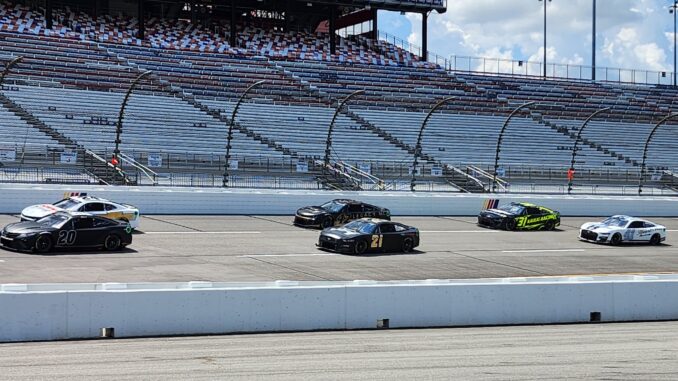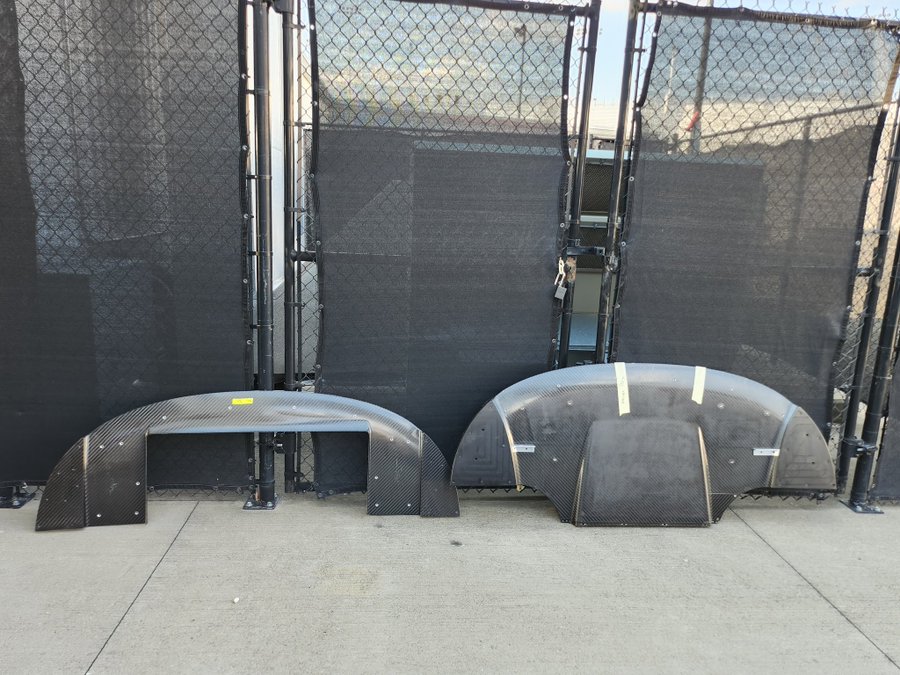
NASCAR came into Richmond with high hopes for a new short track package.
Designed to improve the raceability of the Next Gen car on short tracks like Richmond, where passing has proven a struggle, NASCAR’s Vice President of Vehicle Performance Dr. Eric Jacuzzi saw big gains of up to 100 pounds of downforce mid-corner for a trailing car from the package, allowing to follow and pass.
Sunday’s race was won by Chris Buescher with few on-track passes for the lead. It seemed like Richmond’s Action Track nickname was undeserved.
But drivers in Monday’s test didn’t feel much difference.
“I’d say it’s pretty similar to yesterday,” said Harrison Burton.
“But,” he added, “I’d say yesterday was a pretty decent race too as well. Here we’re able to get outside of each other and run different lanes. It kind of made it to where it’s hard to evaluate.”
Justin Haley echoed that final sentiment. Several drivers had voiced concerns about conducting this test at Richmond, a slick track where tire wear tends to play a bigger role. Haley said those concerns were justified.
“I mean, it’s all we’ve got,” he pointed out, since the planned test a week ago at New Hampshire was canceled once the race was pushed back to Monday for rain.
Still, “I think it’s probably the wrong track and too few cars,” Haley argued. “Richmond’s tough, I think tire wear at Richmond’s probably the biggest thing. So I’d be curious to see it at a more downforce track like Phoenix or Nashville.”
There were just six cars present – Burton, Haley, Noah Gragson, Ryan Preece, William Byron, and Christopher Bell – for a test of a new splitter designed to provide lift for a car in the lead and extra downforce for a car behind.
But Christopher Bell, for one, didn’t notice.
“No, sorry,” he said with a laugh when asked whether he felt the difference. “I applaud NASCAR for trying, it’s cool, but I didn’t notice it, no.”
Bell agreed that New Hampshire Motor Speedway, in Loudon, would’ve been a better place to conduct the test, too.
“That probably would’ve been better than Richmond,” he said.
“All six of us were complaining about being sideways loose. The tracks that we complain about the aero package are places that are high grip, like Phoenix or Martinsville. Loudon would’ve been better than here for sure. Here today you’re just sliding around. You’re never really tight.”
Besides his single car tests, three group runs of two thirty lap stints bisected by a caution to invert the field also didn’t feel any different.
“It was pretty standard Richmond. Probably looking at it you couldn’t tell if it was yesterday’s package or today’s package,” he concluded wryly.

Dr. Jacuzzi was at Richmond to conduct the test.
“Obviously we wanted to go to New Hampshire but the weather didn’t cooperate,” he admitted. “Richmond’s kind of a tougher track to test at because of the tire falloff and all that.”
“We got some discussions on what we could do tomorrow based on their feedback. But good direction, they had a lot of good feedback on tires, and tomorrow we’ve got quite a bit going on with tires, so hopefully that steers us in the right direction as well. So some good learning today for sure, but obviously we wanted a grand slam and didn’t get that,” he acknowledged.
The dialogue was good, said William Byron, who called it a high point of the test.
“Everyone’s real cordial and trying to work through the different options,” he said.
“I feel NASCAR’s really open to suggestions. I feel like it’s good dialogue between everyone and they believe us, they believe what we’re talking about on the racetrack. I feel like there’s a good connectivity there to make changes and there’s some good ideas yet to still work on,” Byron added.
The drivers certainly did see the results Jacuzzi and his team expected after simulation and wind tunnel testing, he admitted.
“Yeah, obviously it’s a little baffling to not get that, but obviously there’s a lot of moving parts on the track. And really here we’re talking about a very small amount of downforce. Yesterday, mid-corner, the car’s only making like 300 pounds of downforce total, and we’re down in the 170-pound range when they’re going 100 [mph], so you’re not talking about big numbers.
“That’s what makes this a little bit tricky. Tires are huge and all the rest of it and the aero’s a small part of this, but a part we feel we can improve.”
The two-day test continues on Tuesday, with a focus on softer Goodyear rubber.
Christopher Bell said he’s hoping both for more grip and more falloff from the softer tire to inject extra variation into a tire strategy race like Sunday at Richmond.
“I think directionally it should be better,” he said of Goodyear’s work. “They said that they were really conservative on the tires starting in 2022 with the Next Gen, so any time that we can make steps to get softer tires and give the drivers more feel.”
Jacuzzi says the aero package testing will continue alongside tire testing, though.
NASCAR now has plenty of real-world data to analyze alongside the theoretical numbers in the hunt to improve the short track package.
“The No. 21 car was carrying the same pressure equipment that we used in the wind tunnel,” he explained, “and we also have video on that. We’re going to go through and post-process that, look at it a little more in depth.”
“We’ve got to spend some time on it. Hopefully we can look and see whether there is a difference and see if it’s the same as we thought, it just takes a little bit of time.”
The next step will be to analyze the data and continue testing in the offseason. Jacuzzi said NASCAR doesn’t want to introduce anything new during the Playoffs.
If any changes are made, then, they’ll appear for the 2024 season at the earliest. Until that point, NASCAR will continue working on honing its Next Gen short track package and producing compelling racing for the drivers and fans alike.
If nothing else, the test produced a humorous moment when Harrison Burton’s team sent him out with a heavily-raised front end. The picture proved popular on social media, even if Burton said it wasn’t all that effective.
No ride height rules for the second #NASCAR short track package group test @RichmondRaceway… good view of the splitter on Harrison Burton's car. @cupscene pic.twitter.com/2s2yfAFT1W
— Owen Johnson (@Owen____Johnson) July 31, 2023
“It was really tight, and it wasn’t great on the short run, that’s for sure. But as the run went on, I had some rear grip at least. But oh man, I don’t think that’s the direction we’re going to continue with,” he acknowledged with a laugh.
“I don’t think so. We’ll see. Just really tight, but maybe we could rebalance it some other way. But it was worth a shot. It’s a great opportunity for us to try some things and think outside of the box.”
“We don’t have a lot of time to do that now with twenty-minute practices, and you kind of have to race what you practice with, and it’s really hard to get out of the box. So it was good for us to do that for sure.”
Regardless of whether it gets used in the race – and perhaps it will, since Burton was able to pass cars with that setup in the test – it provided some levity in the middle of a working day for NASCAR.
- The Monster Mile brings short track style to high banking - April 25, 2024
- Sam Mayer scores Xfinity win by an inch in photo finish at Texas - April 13, 2024
- NASCAR adds Stories to its app for social-style highlights - April 10, 2024